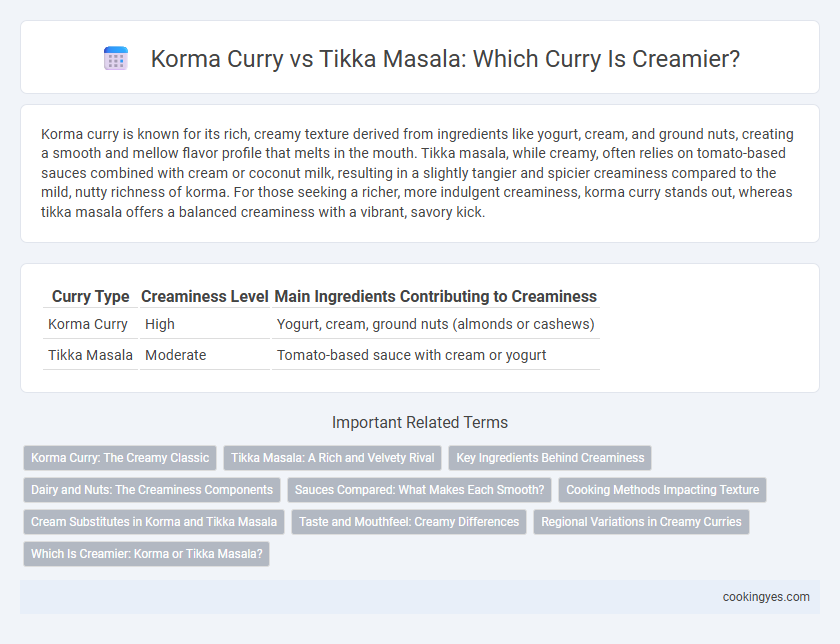Korma curry is known for its rich, creamy texture derived from ingredients like yogurt, cream, and ground nuts, creating a smooth and mellow flavor profile that melts in the mouth. Tikka masala, while creamy, often relies on tomato-based sauces combined with cream or coconut milk, resulting in a slightly tangier and spicier creaminess compared to the mild, nutty richness of korma. For those seeking a richer, more indulgent creaminess, korma curry stands out, whereas tikka masala offers a balanced creaminess with a vibrant, savory kick.
Table of Comparison
| Curry Type | Creaminess Level | Main Ingredients Contributing to Creaminess |
|---|---|---|
| Korma Curry | High | Yogurt, cream, ground nuts (almonds or cashews) |
| Tikka Masala | Moderate | Tomato-based sauce with cream or yogurt |
Korma Curry: The Creamy Classic
Korma curry stands out for its rich, velvety creaminess derived from ingredients like yogurt, cream, and ground nuts, creating a smooth and indulgent texture. Unlike tikka masala, which balances creaminess with a tangy tomato base, korma's mild spices and luxurious sauce offer a buttery, subtly sweet flavor profile. This makes korma curry the quintessential choice for those seeking a classic, creamy Indian curry experience.
Tikka Masala: A Rich and Velvety Rival
Tikka Masala delivers a rich and velvety creaminess characterized by its indulgent tomato-based sauce combined with heavy cream or yogurt, creating a luxurious texture that rivals Korma curry's milder coconut milk and nut paste base. The robust blend of aromatic spices like garam masala and smoked paprika in Tikka Masala enhances its creamy mouthfeel without overwhelming the palate. This distinctive balance of creamy richness and bold flavor positions Tikka Masala as a preferred choice for those seeking a deeply satisfying curry experience.
Key Ingredients Behind Creaminess
Korma curry achieves its creamy texture primarily from ground nuts like almonds or cashews combined with yogurt or cream, creating a rich and smooth consistency. Tikka Masala relies on cream or coconut milk and butter, along with tomato-based sauce, to balance creaminess with tangy flavors. The key ingredient differences highlight Korma's nutty, dairy-rich base while Tikka Masala emphasizes dairy-fat and tomato for a creamy yet vibrant curry.
Dairy and Nuts: The Creaminess Components
Korma curry achieves its signature creaminess through a rich blend of dairy products like yogurt and cream, complemented by ground nuts such as almonds or cashews that add a velvety texture and subtle nutty flavor. In contrast, tikka masala relies more heavily on tomato-based gravy enriched with cream or butter, providing a smoother but less nut-infused richness. The presence of nuts in korma not only enhances its creaminess but also contributes to a distinct aromatic profile absent in tikka masala.
Sauces Compared: What Makes Each Smooth?
Korma curry achieves its signature creaminess through a rich blend of yogurt, cream, and ground nuts like almonds or cashews, creating a smooth, velvety sauce that gently coats the meat or vegetables. Tikka masala sauce relies on tomato puree combined with cream and a complex mix of spices, resulting in a thicker, tangy, and slightly smoky creaminess. The key difference lies in korma's nut-based, mellow richness versus tikka masala's tomato-driven, spiced cream sauce texture.
Cooking Methods Impacting Texture
Korma curry achieves its signature creaminess through slow simmering in a blend of yogurt, cream, and ground nuts, which emulsifies and thickens the sauce, creating a rich, velvety texture. Tikka masala relies on roasting marinated meat before combining it with a tomato-based sauce enriched with cream, resulting in a creamier, slightly tangier consistency due to the integration of charred flavors and dairy. The distinct cooking methods--slow-cooked nut and dairy infusion for korma versus roasted meat melded with a creamy tomato gravy for tikka masala--directly influence the mouthfeel and overall richness of each dish.
Cream Substitutes in Korma and Tikka Masala
Korma curry typically achieves its creamy texture using ground nuts like almonds or cashews blended with yogurt or cream, offering a rich, smooth consistency without relying solely on dairy. Tikka Masala often incorporates heavy cream or coconut milk to create a velvety, luscious sauce that balances its spiced tomato base. For dairy-free alternatives, almond or cashew cream can substitute heavy cream in Korma, while coconut cream serves as an effective dairy-free option to maintain creaminess in Tikka Masala.
Taste and Mouthfeel: Creamy Differences
Korma curry delivers a rich, velvety creaminess derived from yogurt, cream, or coconut milk, creating a smooth and mildly spiced mouthfeel that highlights the subtle flavors of nuts and aromatic spices. In contrast, Tikka Masala features a robust tomato-based sauce combined with cream or butter, offering a thicker, tangier texture with a balanced blend of smoky and spicy notes that provide a more intense and complex taste experience. The creaminess in Korma emphasizes softness and richness, while Tikka Masala balances creaminess with a pronounced boldness in flavor and a slightly firmer mouthfeel.
Regional Variations in Creamy Curries
Korma curry, originating from Mughlai cuisine, is renowned for its rich, creamy texture achieved through a blend of yogurt, cream, and ground nuts, reflecting North Indian culinary traditions. Tikka Masala, which traces its roots to Punjabi cuisine but evolved in the UK, features a slightly tangier creaminess derived from tomato-based gravy combined with cream or yogurt, offering a unique fusion flavor profile. Regional variations emphasize the use of ingredients like almond paste in Korma and tomato puree in Tikka Masala, underscoring distinct creamy curry textures influenced by local tastes and ingredient availability.
Which Is Creamier: Korma or Tikka Masala?
Korma curry is creamier than tikka masala due to its use of yogurt, cream, and ground nuts like almonds or cashews, creating a rich, velvety texture. Tikka masala incorporates tomato-based sauce with cream, resulting in a less dense and tangier consistency. The higher fat content and nut ingredients in korma contribute significantly to its superior creaminess.
Korma Curry vs Tikka Masala for Creaminess Infographic

 cookingyes.com
cookingyes.com